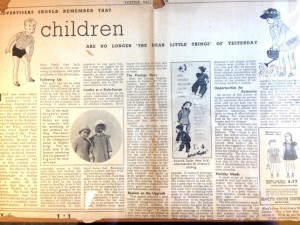March 24, 2014, by Sarah Colborne
Marketing the ‘dear little things’
When cataloguing the records of the Wholesale Textile Association the other day, I came across a thought-provoking article in the trade magazine the ‘Textile Distributor’ from 1935. It offers advice to advertisers concerning the marketing of children’s wear and flags up what it considers to be a growth market: “Fashion counts enormously in presenting any children’s appeal; and its field for exploitation is very wide”
The writer of the article also calls for greater realism in the depiction of children in adverts, suggesting that illustrations should accurately capture their childish mannerisms, and begins with the plea that “Advertisers should remember that children are no longer ‘the dear little things’ of yesterday”.
It recognises the importance of targeting the mother in order to increase sales, as prior to this many women would have been making clothes for children themselves. “If she is shown that her children can only be smart and stylish when their clothes are bought from the shops, and that buying from the shops is the really economic way of clothing children, she would go a long way to increasing the present turnover and profit in small people’s wear.”
The article was intended to be read by those ‘in the trade’, and so reading it now feels like an unsettling glimpse ‘behind the scenes’ of a developing industry which is learning how marketing can play upon insecurities. The advertising images used to market clothing are still under discussion today. Swedish blogger Emelie Eriksson recently highlighted the way in which one clothing company presents its female models semi-naked, while male models wearing the same unisex item of clothing are styled using more traditional poses.
Other records in the Wholesale Textile Association collection show how the textile industry has developed over the years, and how the Association sought to represent the interests of its members in a range of issues: new technological advances; the rights of part time and casual workers; Byssinosis caused by dusts and fibres; introduction of measures to protect consumers; regulations regarding flammability of nightwear; proposed introduction of Sunday trading, etc.
Manuscripts and Special Collections hold the records of a number of trade associations, including the Nottingham and District Hosiery Finishers Association, the Amalgamated Society of Operative Lace Makers and Auxiliary Workers, and the Nottingham and District Trades Union Council. We also have the records of various local business involved in the garment trade, such as Birkin and Co. Ltd, lace manufacturers, Chilprufe Limited, Clothing Manufacturers, Leicester, A.C. Gill Ltd, lace manufacturers of Nottingham, J. and J.W. Leavers, lace manufacturer of Nottingham. Descriptions of these can be browsed via the Business Records and Trade Associations sections of our online catalogue homepage.
For the latest news and images from Manuscripts and Special Collections, follow us on Twitter @mssUniNott
No comments yet, fill out a comment to be the first



Leave a Reply